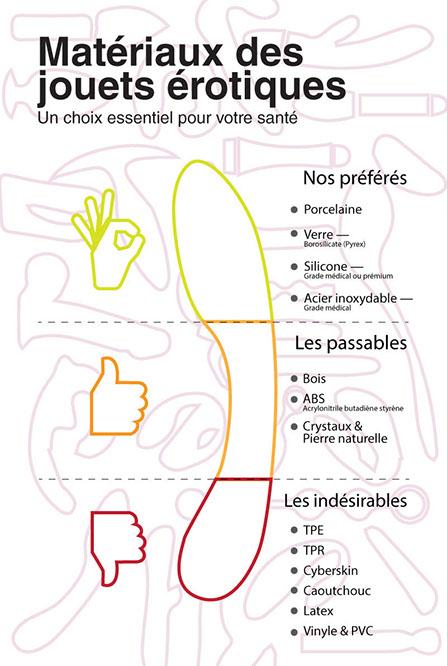To learn more about Les 3 sex* editorial line and the review process, click here.
☛ Cette chronique est aussi disponible en français [➦].
Translated by Audrey Morabito
The erotic toy industry has become a staple in the 21st-century sex realm. According to a 2009 study by the Center for Sexual Health Promotion of Indiana University that surveyed 2056 women and 1047 men aged between 18 and 60 years old, approximately 53% of women and 45% of men use or have used a vibrator, either alone or with a partner (Indiana University, 2009). However, the use of some of these toys is not without health risks for its users.
This health issue is rarely discussed publicly. On the one hand, this subject is hardly covered due to the intimate nature of sex toys. On the other hand, the big players in the industry prefer to keep silent on the matter in order to continue with their already profitable production methods. As a result , there is still progress to be made before talking publicly about the toxic products in sex toys. Consequently, the general public, professionals, and public health agencies have a long way to go in order to be aware of the toxicity of certain products in the industry.
Even so, I believe it is essential for all sexual and pelvic health professionals to know a little more about this reality. As an entrepreneur and founder of a company that specializes in intimate accessories, I will try to convey to you as succinctly as possible everything I have learned about the toxic products in erotic toys.
From Cave to Factory
It is easy to confuse the history of the vibrator with that of erotic toys. Erotic toys have been a part of humanity for several millennia. We can find traces of erotic toys made of stone that date back to the Upper Paleolithic Period. A siltstone dildo, over 28,000 years old, was part of The Institute of Sexology exhibit presented by the Wellcome Collection Museum of London in 2014-2015 (BBC News, 2005).
In February of 2016, the industrial design magazine Core 77 devoted an entire article to the evolution of different erotic paraphernalia through the ages: Sex Toys: A Short Version of a Rather Long History - They’ve been around a lot longer than you might think… In this article, it is explained that, until the industrial revolution, these objects were made like every other utilitarian object, which is to say, by hand with accessible materials such as stone, wood, ceramic or any other easily malleable material (Core 77, 2016).
The vibrator, which appeared more recently, paved the way for mechanized erotic toys. It was invented for physicians in the Victorian era, a time when female “hysteria” was wreaking havoc in Western society. During the industrial revolution, it became obvious these intimate objects would also be swept away in the whirlwind of mechanization. The erotic toys then evolved into machines produced in factories with generic materials such as steel and natural rubber (Maines, 1999). Historian Rachel P. Maines has written a comprehensive book on the invention of the vibrator entitled The technology of Orgasm - “Hysteria” The vibrator, and Women’s Sexual Satisfaction (Maines, 1999).
More recently, the production of erotic toys underwent another major transformation: mass production. Like many other industries, the production of these objects was transferred to Asia in order to reduce the costs of production. In fact, approximately 70% of the world’s production of erotic toys in 2005 was located in China (The Guardian, 2005). In the mindset of cost reduction, many manufacturers have decided to use less expensive materials or to dilute noble materials with additives. In the case of erotic toys, the additives the most often used are phthalates (Taormino, 2009). These plastic additives are of concern to the Canadian Cancer Society, who are currently examining the potential carcinogenic effects of phthalates. In addition, the Canadian Cancer Society categorizes these products as “endocrine disruptors” (Canadian Cancer Society, 2016).
Phthalates
Phthalates are plastic additives generally used to make plastic softer and more flexible. With time, these additives break down and seep to the surface of the object. It is this chemical reaction that explains the “new car smell” is some plastic objects. Phthalates can sometimes provoke an allergic reaction in some people. However, the rule of thumb is that the effect of phthalates is indiscernible. These particles act a little bit like lead, that is to say, that they accumulate in the blood and it is this accumulation that is dangerous. Once in the bloodstream, these particles are redirected to the genitals and are collected by them, atrophying them over time (CDC, 2015; Health Care Without Harm, 2002).
In women, the effect is more perverse since the phthalates can be transmitted to the fetus. In May of 2005, a study on 346 mothers was conducted in order to measure the impact of phthalates on the development of the fetus. According to the team’s findings, the presence of high levels of phthalates in the mother atrophies and hinders the development of the genitals in male fetuses (Swan et al., 2005). As a result, these additives are already banned in children’s toys. However, no such regulation is in sight for adult products (INSPQ, 2014).
Unhygienic Surfaces
Some manufacturers use more “accessible” materials in order to reduce costs of production and to increase their profits. However, these materials such as PVC or jelly are porous in addition to containing phthalates. Porous materials have a surface finish similar to a sponge, that is to say, the surface is not sealed. Have you ever tried to clean and disinfect a sponge? Mission impossible.
These materials are usually found in more “affordable” erotic toys. The toys with a porous surface are dangerous for health because it is impossible to clean them between uses or if shared amongst partners (Taormino, 2009).
Manufacturer’s Ethics
My experience as an entrepreneur and founder of an erotic toy company allowed me to see that some manufacturers try to reduce the harmful impact of their products by including indications in instruction manuals. Included in them are warnings such as “for external use only”, “for use with a condom” or “for single-use”.
However, most users do not consult the whole instruction manual that is provided by the manufacturer. Also, most in-store salespeople are not informed about the different precautions concerning the products in their inventory.
This way of shirking ethical responsibilities also applies to complimentary cleaning products sold for erotic toys.
Overall, just keep in mind that the erotic toy industry and all related accessories such as cleansers, lubricants and massage oils are not regulated.
The Body Without Its Natural Defenses
Products, such as phthalates and less hygienic materials, pose an even greater problem when part of the objects are designed for internal use. Normally, the skin serves as a barrier against contaminants. However, in the case of the vagina or the anus, these dangerous products come directly in contact with the mucous membranes, which gives them direct access to the bloodstream (U.S. National Library of Medicine, 2016).
As mentioned earlier, the body does not react immediately to contact with phthalates. It is the repeated use of dangerous products that cause the most damage. Unfortunately, most people use the same erotic toys for many years (Health Care Without Harm, 2002).
How to Find Your Way
All hope is not lost! According to my experience in the field of erotic toys and my constant quest for healthier and more responsible products, I discovered that certain manufacturers already use biocompatible materials. These materials are completely inert and harmless to health. Also, in recent years, some stores have become aware of this problem and offer selections of “phthalates-free” products or refuse to sell them completely.
In order to find your way through all these toxic and safe materials, I created an infographic (French only) that allows you to quickly identify if a toy is made with friendly materials or not.

Note that manufacturers are not obligated to divulge the ingredients or components of their products... That is why it is important to favour manufacturers who are transparent about their manufacturing methods.
For the curious, there are many videos and documentaries available on the subject on YouTube. Just search the following keywords: “phthalates” or “endocrine disruptors”. Actually, “La Grande Invasion - Documentaire by Stéphane Horel for France 5, 2010” is an excellent documentary available on YouTube.
I also suggest you read this post on the subject by the Kinsey Institute.
To cite this article:
Deslauriers, I. (2016, November 29). These Toxic Toys. Les 3 sex*. https://les3sex.com/en/news/250/chronique-ces-jouets-toxiques-

Comments